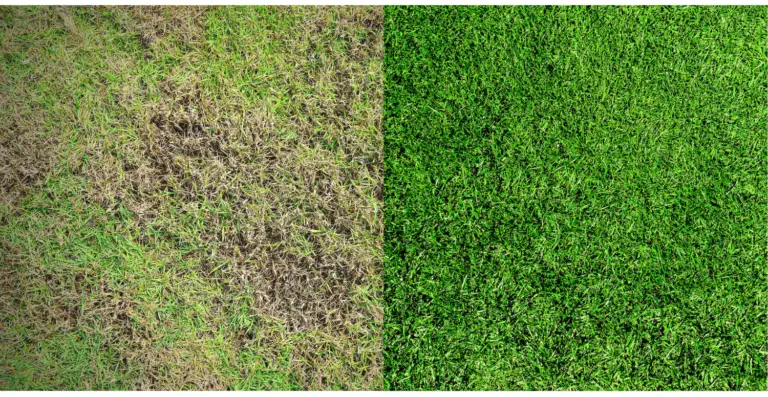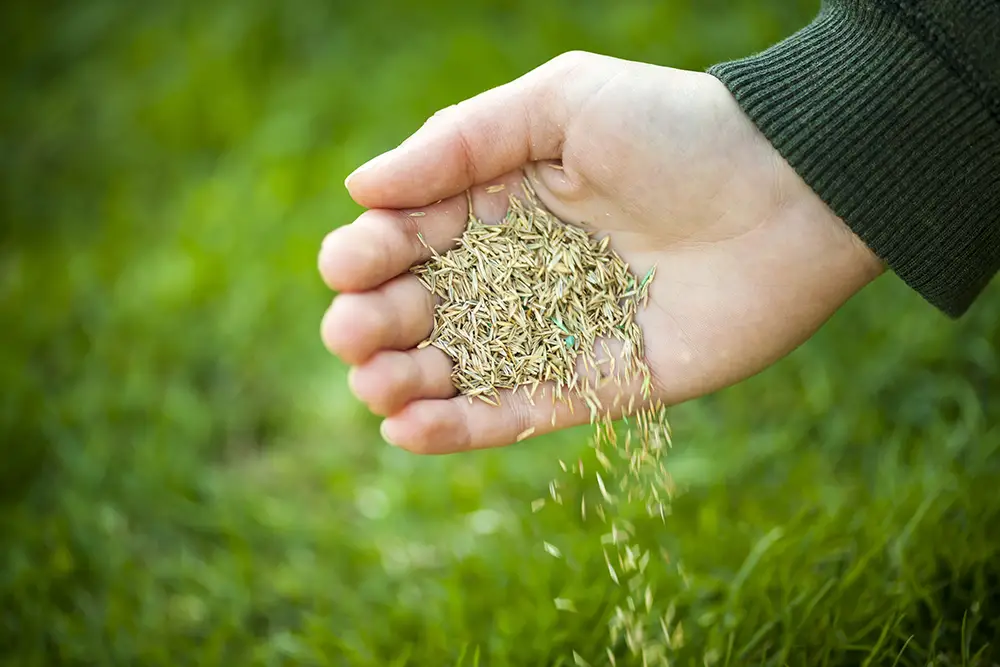Bermuda grass is a great warm-season turf for those who wish to grow a lush, full lawn that spreads easily. When properly cared for, Bermuda grass will thrive even under heavy foot traffic and hot, dry weather. However, every lawn faces challenges – maybe you went on a long vacation, or had a particularly cold winter, and the lawn is having a hard time bouncing back. When Bermuda grass starts to look thin you can promote new growth and fill in the bare spots by overseeding. Here’s the right time to overseed Bermuda Grass and how it should be done:
Bermuda grass should be overseeded in the Spring or the peak of the growing season. This gives the new seed the right environmental conditions to germinate and take root.
Read on to find out the more in-depth answer to the best time to overseed Bermuda grass, how to overseed Bermuda grass, and what varieties of grass seed you should use. Let us answer all your questions on overseeding your Bermuda grass lawn!
The Benefits of Overseeding a Bermuda Grass Lawn
- Thicker, denser turf. Overseeding will result in more grass to fill any thin spots and result in a thick, dense carpet.
- Lower maintenance lawn. When lawn turf is dense enough, there is less room for weeds, pests, or disease.
- Growth regulation. Adding Bermuda seed to a perennial lawn will help regulate growth for an even lawn all year round.
- High tolerance. Bermuda grass is highly drought and heat resistant, especially when it has a deep and plentiful root system – achieved by overseeding.
The Best Time to Overseed a Bermuda Grass Lawn

Overseed your Bermuda grass lawn too early in the year, and you could risk the cold-weather stopping the germination process. Temperatures below zero will kill the seed. A Bermuda grass seed needs a warm environment in order to germinate because it is a warm climate grass. Try overseeding your lawn too late in the growing season, and you may see the germination process stunted. Dry or cool conditions will slow the process down from one week to three weeks.
Make sure to give a newly seeded lawn at least three months before overseeding. Newly seeded Bermuda grass will need this time to establish strong roots before competing with new seeds for space.
The Right Conditions For Overseeding
The right soil temperature, moisture, and oxygen are all equally important for the seed to take root. The soil should be around 65 degrees Fahrenheit. Make sure your lawn is well watered right after overseeding, but not waterlogged. Excess rain or watering may wash the new seeds away or stop them from getting the oxygen they need to germinate. Another way to encourage new growth is to aerate your lawn before overseeding. This will help make sure seeds fall down into the soil, but still, get plenty of oxygen. If you want to overseed without aerating, quickly go over your lawn with a large garden fork and stab some holes in the soil.
Pro tip: Irrigate daily for 10 days after overseeding before going back to your regular watering schedule.
How Long Does it Take Overseeded Grass to Grow?
The germination process, once begun, actually takes less than a week in the right conditions. Once Bermuda grass has germinated, it will grow at a rate of about 2-3 cm per week. This means it takes approximately one to one-and-a-half months before the new grass is caught up to the original growth.
Pro tip: Let the new grass grow 2-3 inches high before mowing your lawn. After the first cut, apply a fertilizer high in nitrogen for a growth boost and a deeper green.
How to Overseed Bermuda Grass

- Mow the lawn to one inch
- Clear debris or with a rake or dethatch
- Apply 3 lbs of Bermuda grass seed per 1000 square foot
- Water in well
For a uniform look, it is recommended when overseeding Bermuda grass to use the same variety that you already have planted. However, if you live in a cooler climate zone, you may want to integrate a perennial grass type to supplement the sad, dormant Bermuda that you are left with in the winter. In this case, there might be a different answer as to when and how to overseed Bermuda with perennial grass.
Overseed Bermuda with Ryegrass
Perennial Ryegrass is an attractive, winter-hardy variety of turfgrass that can be seeded over existing Bermuda grass. The first step is to mow the Bermuda grass short and clear the lawn of any debris such as old rhizomes (above ground roots). This is so the seeds can easily come in contact with the soil. Make sure when overseeding with Perennial Ryegrass that daytime temperatures are in the high 70s and nighttime temperatures are about 55 degrees at the most. You will need about 10lbs of Ryegrass seed per 1000 square feet, and a lawn spreader to ensure even distribution. Remember to irrigate regularly for 10 days after laying down the seed. Enjoy a green, healthy-looking lawn all year round!
Overseed Bermuda with Fescue
Using the cool-season grass Fescue in combination with Bermuda is a little more complex. Fescue is a tall grass that thrives when allowed to grow, while Bermuda looks best cut shorter and is more of a spreader than a grower. In addition, each variety requires a different fertilizing schedule. This is why it is recommended to overseed a Bermuda grass lawn with Ryegrass instead. However, for the purpose of getting a green lawn during the winter, Fescue will do the trick. Follow the same steps that you would in putting down any other perennial grass seed, such as Ryegrass, and get a lawn with color and growth each season.
Pro tip: You can always remove unwanted Fescue in the spring with a selective herbicide to reduce competition between the two varieties during the growing season.
Lawn Care After Overseeding
After overseeding Bermuda grass, the lawn will need a little extra care and attention. Keep these tips in mind the first month after overseeding.
- Take care to reduce foot traffic on your lawn. The less the lawn is disturbed, the better chance the new seedlings have of growing.
- Water in the mornings. Make sure the lawn does not go dry during this period.
- Do not mow before the fourth week after overseeding. Give the grass a chance to grow. When you do mow, make sure the blades are sharp.


